The Flying Bat Nebula (Sh2-129) is a large H II region located approximately 2,300 light years away in the northern constellation Cepheus (the King). The faint emission nebula has an apparent size of 140 arcminutes and appears near Alderamin (Alpha Cephei) and the better-known Elephant’s Trunk Nebula (IC 1396).
The large region of atomic hydrogen is ionized by the intense light of hot, bright stars that formed within its clouds. The clouds of ionized gas will eventually be eroded and blown off by the radiation pressure from the young stars.
Sh2-129 was named the Flying Bat Nebula because its brightest parts are said to resemble a bat in flight. The cloud of hydrogen gas contains the blue Giant Squid Nebula (Ou4), a smaller nebula whose origin and distance have long puzzled astronomers.
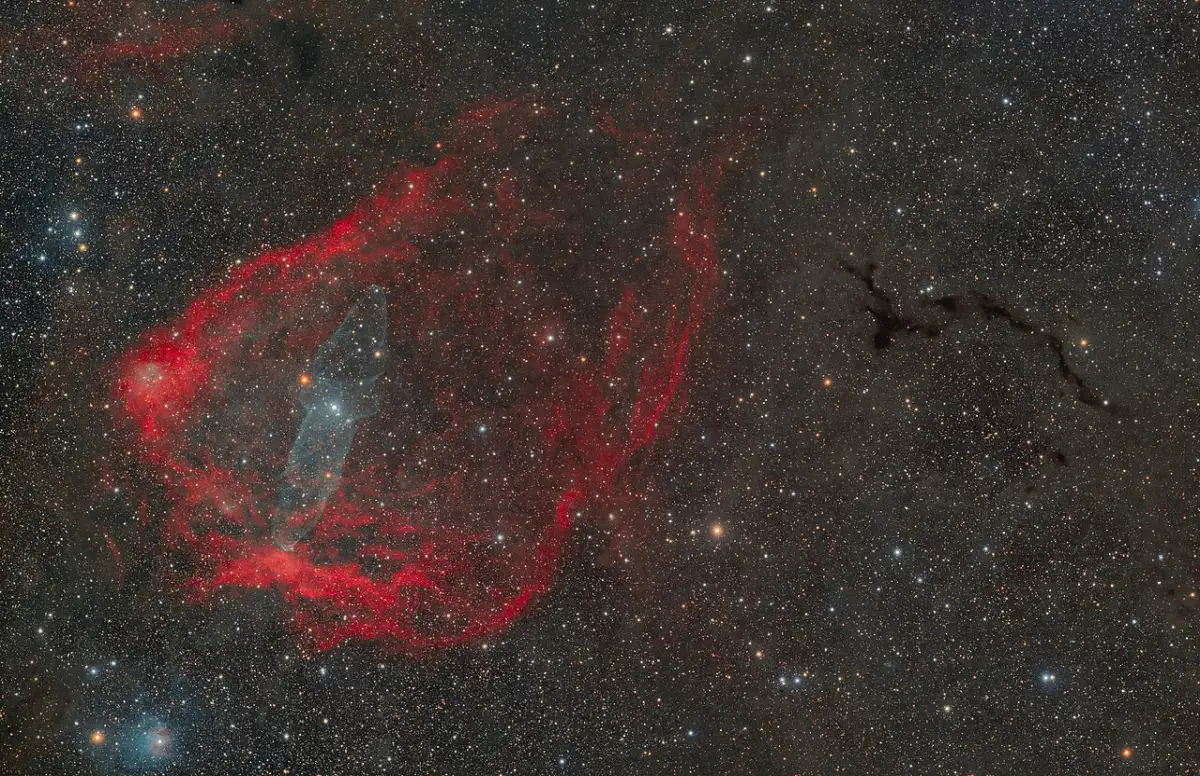
Discovered by French astro-imager Nicolas Outters, the bipolar shape and emission are consistent with it being a planetary nebula, but its actual distance and origin are unknown. Recent investigation suggests Ou4 really lies within the emission region SH2-129 some 2,300 light-years away. Consistent with that scenario, the cosmic squid would represent a spectacular outflow of material driven by a triple system of hot, massive stars, cataloged as HR8119, seen near the center of the nebula. If so, this nebula would physically be nearly 50 light-years across. Image credit: Giuseppe Donatiello (CC0 1.0)
The hot blue B-type star HD 8119 appears in the central part of the Squid Nebula. It has an apparent magnitude that varies between 5.51 and 5.57 and has been identified as a triple star system. The young star system may be a member of the Cepheus OB2 association, the Flying Bat Nebula region, or the open cluster Trumpler 37.
It is uncertain whether HD 8119 is associated with the Squid Nebula. On the one hand, the nebula’s prominent O III lines are consistent with an exceptionally hot central star. On the other, the young star system has not likely evolved to the planetary nebula stage and may be too massive to produce a planetary nebula. The Squid Nebula may instead be a bipolar outflow from one of the massive stars in the hot young triple system.
The cosmic Squid was originally thought to lie much closer to us than the Flying Bat. The bipolar nebula was believed to have been produced by a regular low-mass star that expelled its outer gaseous layers into space as it reached the end of its life cycle.
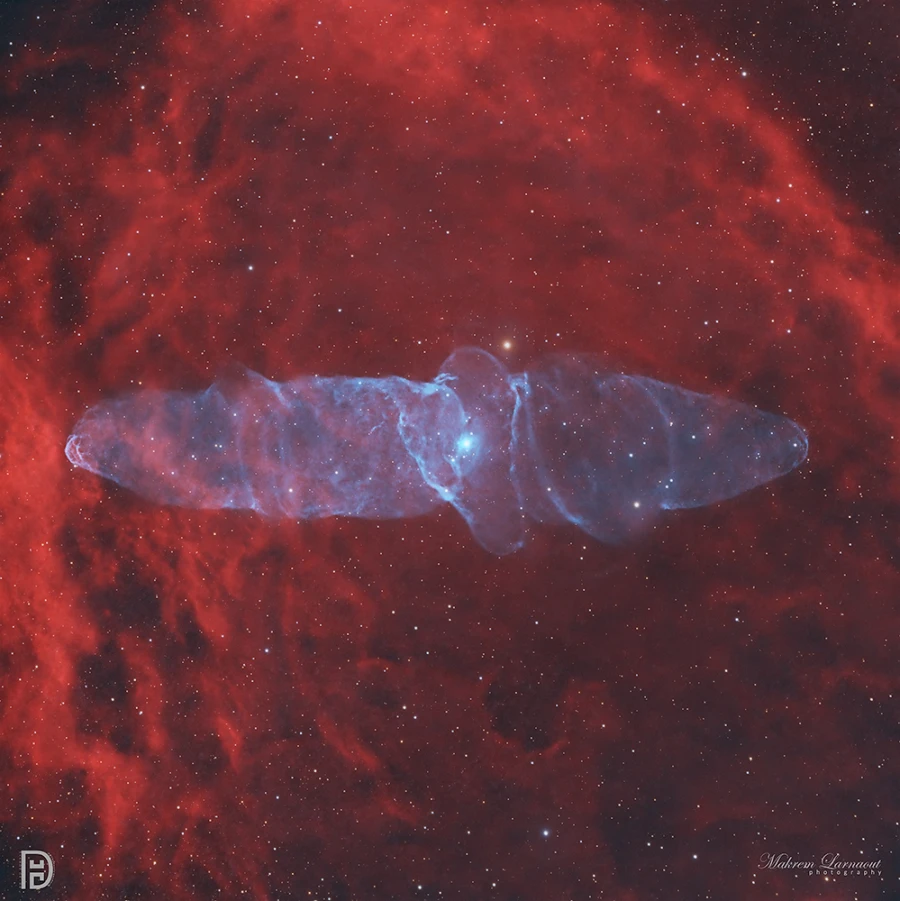
An extraordinary astrophotography expedition in collaboration with Mr. Hafedh Driss, as we set out to capture a challenging target: the Giant Squid. Over the course of four consecutive nights, we embarked on a mission to collect pristine data using two different telescopes: the William Optics GT81 and the SkyWatcher ED80 Esprit. Underneath a magnificent sky adorned with excellent transparency, our focus was to capture the elusive Giant Squid using narrowband filters. We specifically targeted the Ha (Hydrogen-alpha) and O3 (Oxygen III) wavelengths, which would allow us to highlight the intricate details of this celestial wonder. To ensure accuracy and depth in our final image, we complemented the narrowband data with RGB (Red, Green, Blue) exposures of the surrounding stars. Image credit: Makrem Larnaout (CC BY-SA 4.0)
The nebula is now believed to be a bipolar outflow from a massive young star, HD 8119, that lies at a similar distance to the Flying Bat Nebula. The Giant Squid has a small central disk and two large, elongated lobes extending in opposite directions.
At the time of discovery (2011), the Giant Squid Nebula had the largest angular extent of any known planetary nebula. The oxygen-rich bipolar nebula is over a degree across. It has an angular size of 1° 9′ 24″ by 19′ 48″. The nebula’s large size has led astronomers to propose that it may be the nearest planetary nebula discovered to date. However, if it lies at a greater distance, it may be one of the largest bipolar nebulae ever discovered.
The Squid Nebula appears similar to several other bipolar nebulae, including the Ant Nebula (Menzel 3, Mz 3) in the constellation Norma, Minkowski’s Butterfly (the Twin Jet Nebula, M2-9) in Ophiuchus, and KjPn 8 in Cassiopeia.
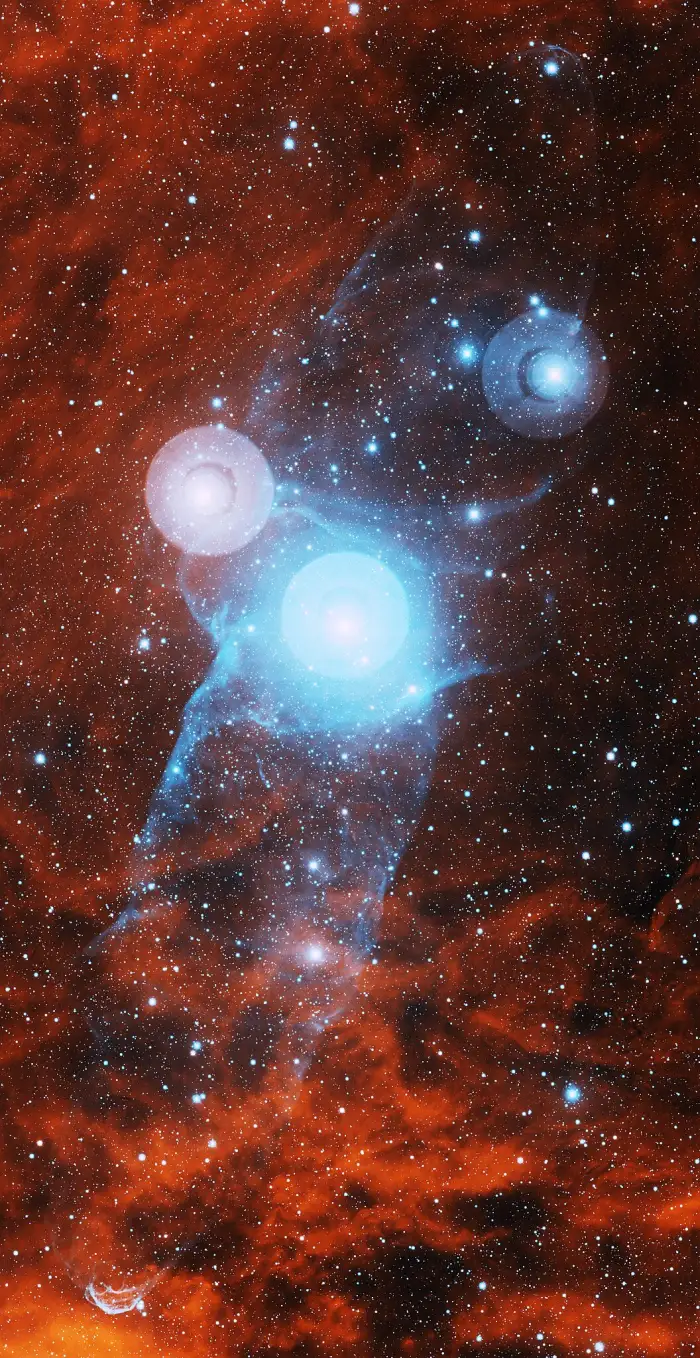
This image was obtained with the wide-field view of the Mosaic camera on the Mayall 4-meter telescope at Kitt Peak National Observatory. Outters 4 is a bipolar nebula (seen in blue) that is embedded in the giant HII emission nebula Sh2-129 (seen in red). It was discovered by amateur astronomer Nicolas Outters. It is not yet clear if Outters 4 is associated with HR 8119, the bright star at the center of the image. The image was generated with observations in Hydrogen alpha (red) and Sulphur [S II] (blue) filters. In this image, North is up, East is to the left. Credit: T.A. Rector (University of Alaska Anchorage) and H. Schweiker (WIYN and NOIRLab/NSF/AURA) (CC BY 4.0)
Facts
The Flying Bat Nebula was discovered by the American astronomer Stewart Sharpless in the late 1950s. He included the object as Sh2-129 in his 1959 catalogue of H II regions, noting that it was part of the Cepheus I association.
The smaller Squid Nebula (PN G 098.6+07.9) was discovered by the French amateur astrophotographer Nicolas Outters in May 2011. Outters took several photos of the Flying Bat using an FSQ-106 refractor and a CCD camera with H-alpha, [S II] and [O III] filters. The images taken with the OIII filter with a total 12.5 hours of exposure revealed a large structure within the Flying Bat that was not visible in H-alpha or S II. He called the structure “le Calamar” (the squid).
Outters contacted the French astrophysicist Agnès Acker of the Observatoire Astronomique de Strasbourg, who confirmed the presence of oxygen III and reported the discovery in 2012. The nebula is catalogued as Outters 4 (Ou4) as the fourth object discovered by Outters.
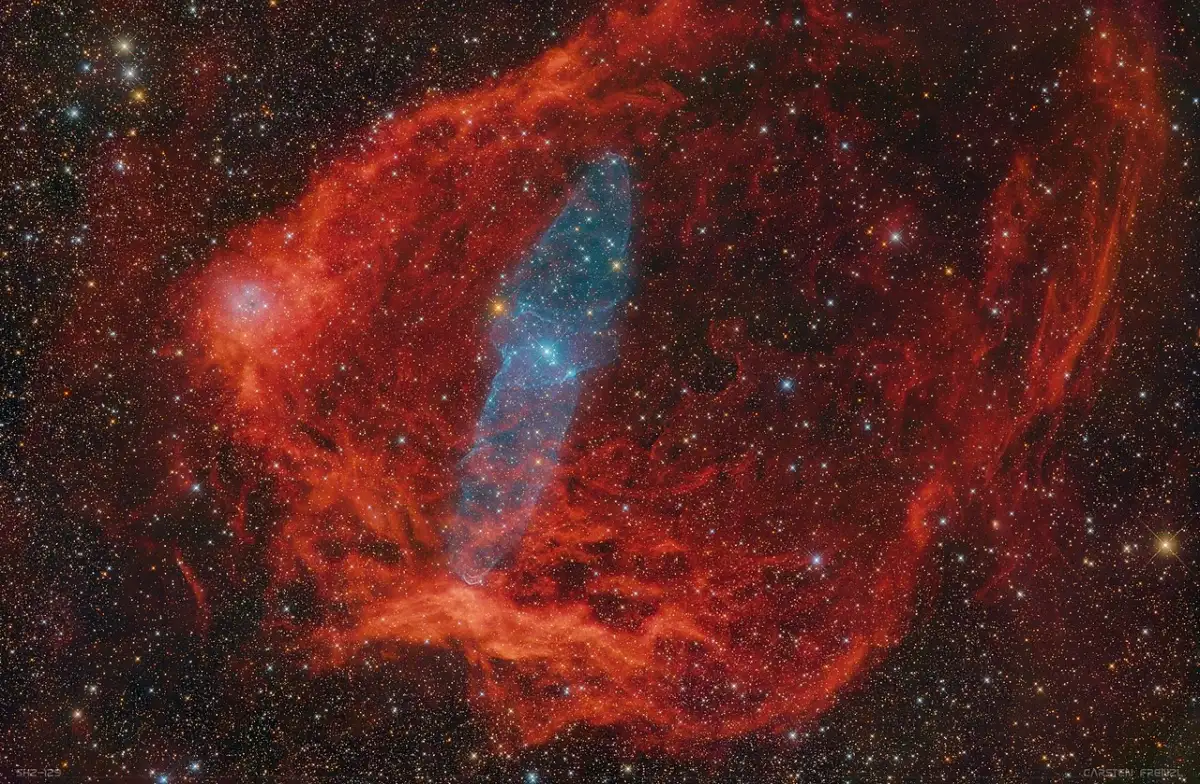
Flying Bat and Giant Squid Nebulae, image credit: Carsten Frenzl (CC BY 2.0)
Location
The Flying Bat Nebula lies near Alderamin, the brightest star in Cepheus, in the direction of Deneb in Cygnus. Alderamin can be found by drawing a line through the rightmost stars of Cassiopeia’s W.
The large emission nebula IC 1396, which contains the famous Elephant’s Trunk Nebula (IC 1396A), appears in the same region of the sky. The Flying Bat and Elephant’s Trunk nebulae appear almost parallel to the imaginary line connecting Alderamin and the red supergiant Zeta Cephei in the constellation figure of the King.
At declination +60°, the Flying Bat Nebula is best seen from the northern hemisphere. It never rises for observers south of the latitude 30° S. The faint nebula is best seen in long-exposure images.
The best time of the year to observe the Flying Bat and other deep sky objects in Cepheus is during the month of November, when the constellation appears high above the horizon around 9 pm.

Location of the Flying Bat Nebula, image: Stellarium
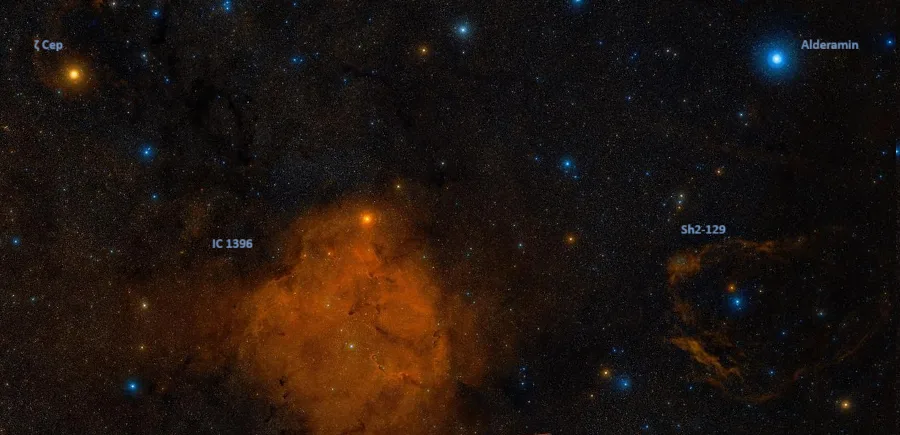
Flying Bat and Elephant’s Trunk nebulae, image credit: ESO/Digitized Sky Survey 2 (CC BY 4.0)
Flying Bat Nebula – Sh2-129
| Constellation | Cepheus |
| Object type | H II region |
| Right ascension | 21h 11m 48.0s |
| Declination | +59° 57′ 00″ |
| Apparent size | 140’ |
| Distance | ~ 2,300 light-years |
| Names and designations | Flying Bat Nebula, Sharpless 129, Sh2-129 |
Images
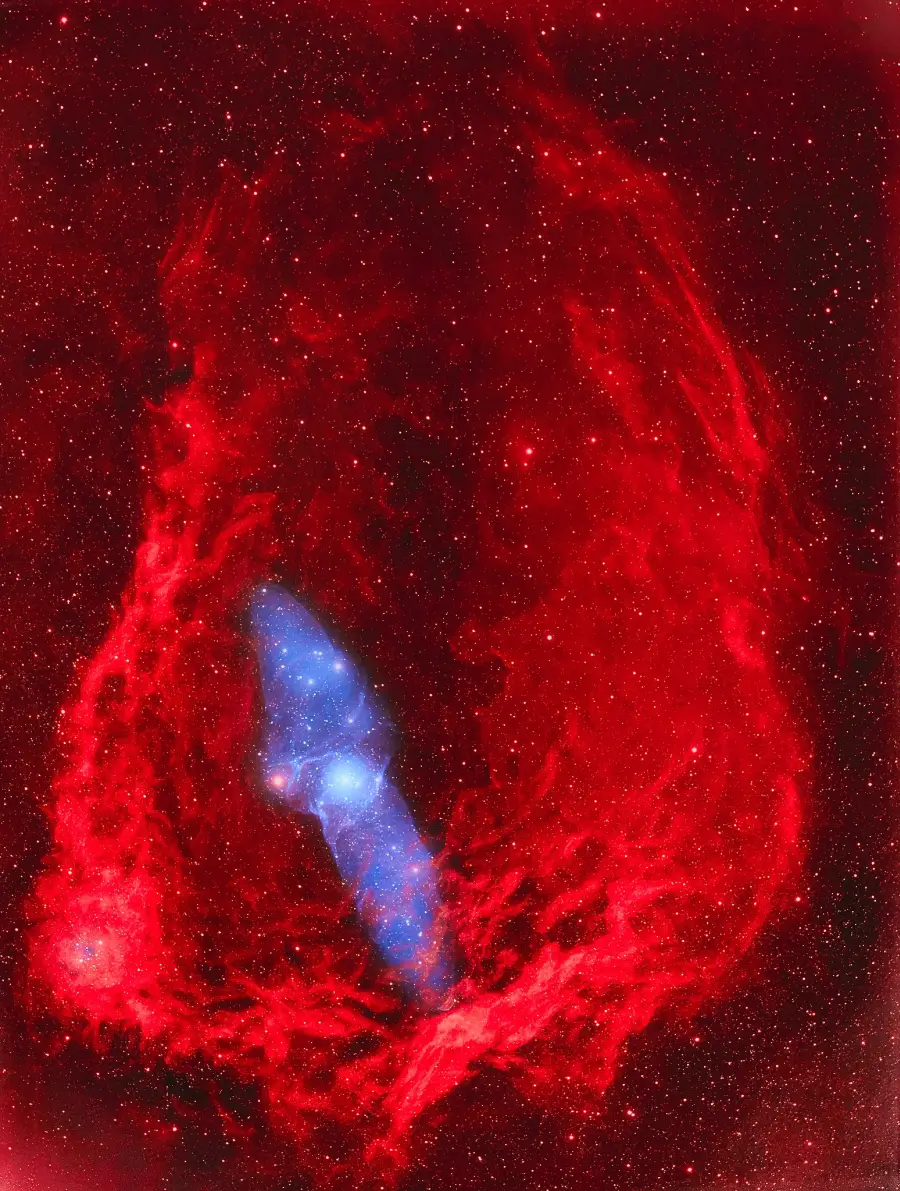
Flying Bat (Sh2-129) and Giant Squid (Ou4) nebulae, image: Ram Samudrala (CC BY 4.0)
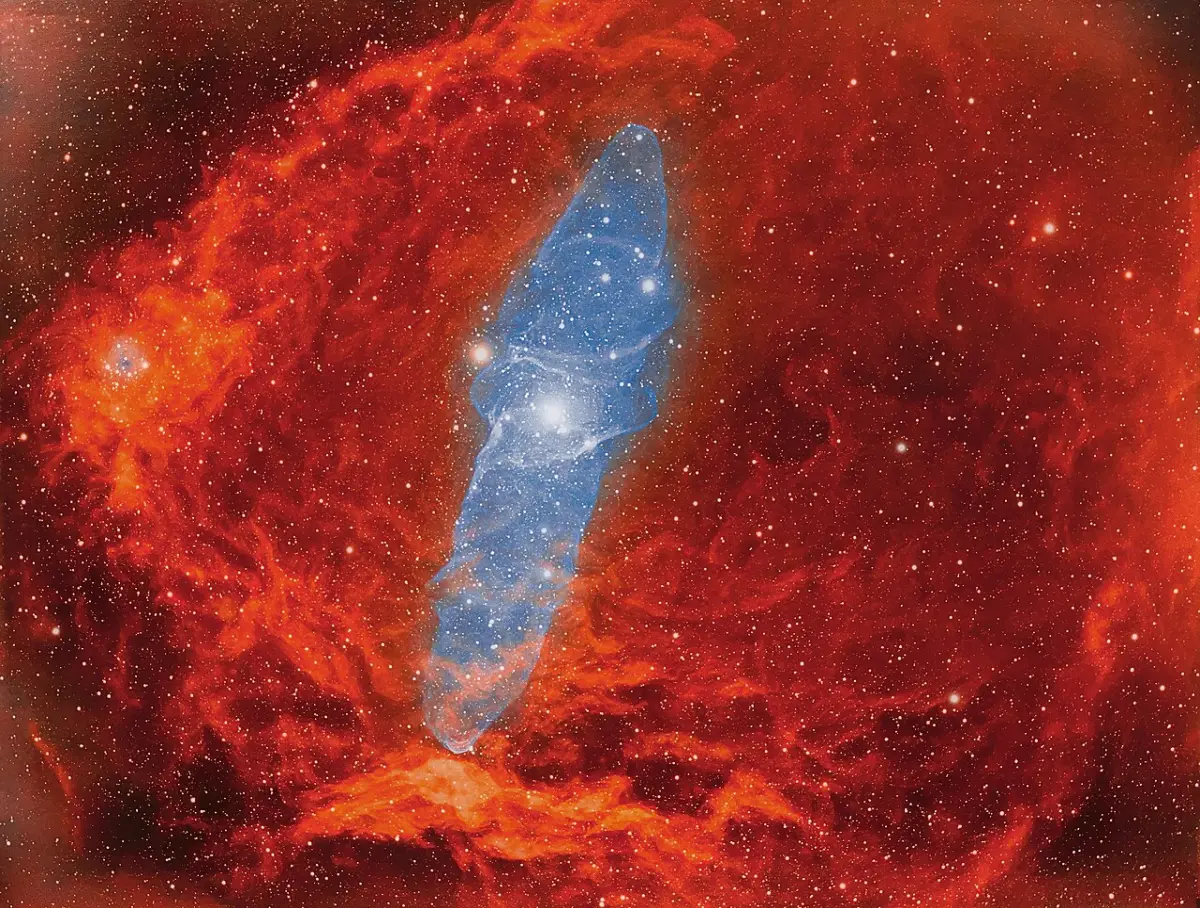
Squid Nebula (Ou4), image: Ram Samudrala (CC BY 4.0)

Sometimes called the “Flying Bat” nebula, this region is characterized by hydrogen emission. Inside it we found the recent discovery made in 2011 by Nicolas Outters, called the “Squid Nebula” due to its shape, but more officially called Ou4. This region is characterized by a very faint OIII emission and its bipolar shape reminds of a planetary nebula. Image credit: Maurizio Cabibbo (CC BY-SA 4.0)